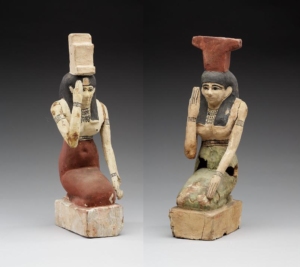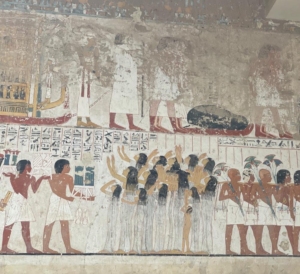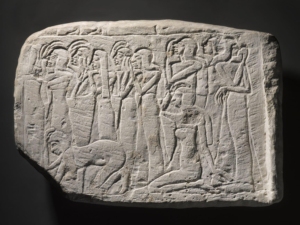Crying for the Departed: How mourning women helped the dead reach the afterlife in ancient Egypt
For much of Egyptian history, death was considered to be a dark, cold, and lonely silence. Consequently, the ancient Egyptians created a series of elaborate funerary rituals to secure safe passage to the afterlife and immortality for the dead. For the deceased to overcome death and be ‘reborn’ in the afterlife, each set of participants needed to execute their roles perfectly.

Pair of kneeling figures of Isis and Nephthys in mourning positions, Ptolemaic period, courtesy the Metropolitan Museum of Art.
Starting in the Old Kingdom period (ca. 2686-2130 BCE), depictions of the Egyptian funeral emphasized their highly elaborate nature. The lively scenes transport the viewer back in time, immersing them in the rich multisensory experience of an ancient Egyptian funeral procession—the air thick with the scent of burning incense, the rhythmic shuffling of dancers’ feet, a steady procession of offering bearers and oxen dragging the funeral sledge, solemn chants of priests reciting magical spells, and the piercing cries of mourners weeping over the dead.
Although artistic and textual evidence of male lamentation exists in Egyptian tombs, mourning was a heavily female-dominated activity, likely because of the rituals’ ties with rebirth. These women typically wore ankle-length sheath-like dresses that were held up by one or two straps or tied beneath their chests, exposing one or both breasts. Additionally, some mourners adorned their heads with a colored tie, while their hair was depicted in various styles—loose and flowing, cropped, or loosely tied at the nape.
Evidence from coffins, papyri, statuary, and tomb walls, like those of Rekhmire (TT 100) and Neferrenpet (TT 178), tell us that there were two classifications of mourning women: divine and human. Hired mourners and the deceased’s female family members made up the human mourners, and their collective focus was on lamenting the dead. They typically followed the deceased’s coffin in huddled groups, supporting each other, wailing, and reaching out toward the coffin. Professional mourners were commonly depicted in processional scenes leading to the tomb, as seen in tombs of nobles such as Niankhhathor, Paheri (El-Kab), and In-snefru-ishtef, among others. They were often shown standing with one or both hands held open at their sides, walking with a hand near their hearts, or positioned at either end of the coffin.
Alternatively, divine mourners were more subdued and stoic in their gestures and attitudes. Their primary function lay in the protection of the deceased’s body and his or her regeneration in the afterlife; mourning was a secondary function. These women often wore crowns with hieroglyphs on top that identified them as Isis and Nephthys, the original mourning goddesses in the Osiris myth.

Female mourners weeping and reaching out to the coffin from the tomb of Ramose, Dynasty 18, photo by author.
In one version of this myth, these sisters mourned the death of their murdered brother Osiris—and in the case of Isis, also her husband—working tirelessly to resurrect him. Transforming into kites, the pair travelled around Egypt collecting the dismembered pieces of Osiris and reanimated him with magic. Isis then gave birth to Horus, the rightful heir who avenged his father, and Osiris took his place as lord of the underworld. Thus, balance was restored to the universe. Their actions set a divine precedent for human funerary practices, making mourning a significant and, sacred act. In Egyptian mortuary belief, Osiris became the prototype of every deceased individual. The deceased would be likened to Osiris and follow in his fortune in perpetuity if the funerary rites were completed perfectly.
During the New Kingdom, it became increasingly common for widows to be depicted clutching at the deceased’s feet during the final burial rites outside the tomb. Mourners often bared their breasts while weeping or throwing dust on their heads, forming a characteristic part of a highly orchestrated, theatrical performance to emphasize the deceased’s social and moral standing in his lifetime and ensure his safe passage to the afterlife in death.

Relief of Mourning Women, Saqqara, Dynasties 18-19, courtesy of the Brooklyn Museum.
In addition to physical expressions of mourning, inscriptions and texts give us information about verbal lamentations. Mourners would call out to the dead, emphasizing their permanent separation, or use metaphors relating to storm-battered ships or crumbling houses that clearly reflected the longing, helplessness, and loneliness of those left behind. For example, a tomb caption from the 18th dynasty (c. 1550-1292 BCE) tomb of Neferhotep (TT 49) shows his wife speaking to his coffin outside the entrance to the grave:
O great one, do not abandon me […]
Since your counsel was good.
O good father, my (very) own,
Going away, how can you do it?
But look, now, I am behind you!
O you who loved to talk with me,
You are silent, and do not speak.
This lament highlights the themes of isolation, unrequited yearning, and silence brought on by death in ancient Egyptian thought—Neferhotep’s wife is permanently separated from her husband, desperately trying to reach him but knowing he cannot respond.
Death and the realm of the dead, as a place of the most distant distance, had largely negative connotations—it was dark, lonely, and silent. The loss of a loved one, combined with the uncertainty of death, left the bereaved feeling helpless and out of control. This led to intense, unbridled expressions of grief, such as screaming, crying, collapsing to the ground, or even self-injury. The act of mourning was a way for the bereaved to channel those emotions to ease their fears about death. By expressing their grief through ritual, they not only aided their loved one in his journey to the afterlife but also underwent their own emotional transformation.
The cries of mourning women embodied individual and communal pain, fear, and insecurity while playing into the ritual that instilled hope for their loved one to be reborn in the afterlife as a glorified spirit. All of these provided relief for those left behind, helping them to accept their loss and eventually adjust to their new realities.
Suggestions for further reading
Assmann, Jan. Tod und Jenseits im alten Ägypten (München: C.H. Beck, 2001).
Bleeker, C. J. “Isis and Nephthys as Wailing Women.” Numen, Vol. 5, Fasc. 1 (Jan., 1958): 1-17.
Faulkner, R.O. “The Bremner-Rhind Papyrus: I. A. The Songs of Isis and Nephthys.” The Journal of Egyptian Archaeology, vol. 22, no. 2 (Dec., 1936): 121-140.
Kucharek, Andrea. “Totenklage und Osirisklage zwischen Negierung und Transzendenz.” In Klagetraditionen: Form und Funktion der Klage in den Kulturen der Antike (Freibourg: Academic Press Fribourg, 2011), pp. 21-38.
—. “Mourning and Lament in Ancient Egypt.” In How to Cope with Death: Mourning and Funerary Practices in the Ancient Near East: Firenze, 5-6 December 2013, pp. 67-82. Ricerche di archeologia del Vicino Oriente. Pisa: Edizioni ETS, 2016.
Riggs, Christina. “Mourning women and decorum in ancient Egyptian art.” In Decorum and Experience: essays in ancient culture for John Baines, (eds.) Elizabeth Frood and Angela McDonald (Oxford: Griffith Institute, 2013), pp. 156-162.
Sweeney, Deborah. “Walking Alone Forever, Following You: Gender and Mourners’ Laments from Ancient Egypt”, NIN 2, 1 (2001): 27-48.
Valdesogo, María Rosa. Hair and Death in Ancient Egypt: Mourning Rites in the Pharaonic Period (Zandvoort: BLKVLD, 2019).
Werbrouck, M. Les pleureuses dans l’Égypte ancienne (Bruxelles: Fondation Égyptologique Reine Élisabeth, 1938).